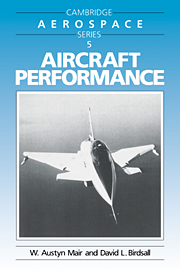Book contents
- Frontmatter
- Contents
- Preface
- Introduction
- 1 Aerodynamic foundations
- 2 Basic flight theory
- 3 Drag equations
- 4 Climbing performance
- 5 Power plants
- 6 Take-off and landing performance
- 7 Fuel consumption, range and endurance
- 8 Turning performance
- 9 Vectored thrust
- 10 Transonic and supersonic flight
- Appendixes
- References
- Index
Introduction
Published online by Cambridge University Press: 02 December 2009
- Frontmatter
- Contents
- Preface
- Introduction
- 1 Aerodynamic foundations
- 2 Basic flight theory
- 3 Drag equations
- 4 Climbing performance
- 5 Power plants
- 6 Take-off and landing performance
- 7 Fuel consumption, range and endurance
- 8 Turning performance
- 9 Vectored thrust
- 10 Transonic and supersonic flight
- Appendixes
- References
- Index
Summary
The performance of an aircraft is essentially a statement of its capabilities and a different selection of these will normally be specified for the various categories such as transport, military and light aircraft, even though several common performance factors will feature in every such selection. For the engineer involved in the creation of a new design, these performance features serve as design criteria or at least desirable objectives, whereas late in the design and development stages the sales staff will quote the performance features as the basis for the commercial strength of the emerging aircraft. For either reason the performance will be stated in terms of quantities such as direct operating cost (DOC), maximum range for various payloads and fuel loads, cruising speed and airport requirements for landing and take-off. While the sales and design attitudes will be distinct, although related, this book addresses the early stages of the design process which must also bear considerable allegiance to performance as viewed by a potential customer.
The estimation of performance proceeds in stages, starting with parametric studies based on simple assumptions and progressing to more refined calculations as the main features of the design become established and the confidence in data grows. Estimation techniques are important not only because they allow the engineering team to proceed while data are crude or speculative, but also because construction of the new aeroplane will begin well in advance of the engineering refinements, and if there is accuracy in the early estimations this will be rewarded by a reduction in modifications as the fabrication and assembly effort progresses toward regular production.
- Type
- Chapter
- Information
- Aircraft Performance , pp. xix - xxPublisher: Cambridge University PressPrint publication year: 1992



